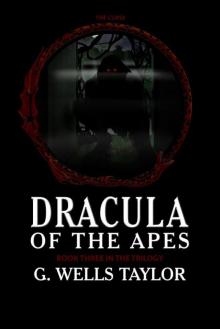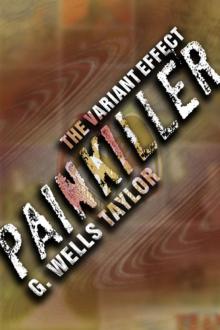- Home
- G. Wells Taylor
Dracula of the Apes 2
Dracula of the Apes 2 Read online
DRACULA OF THE APES
Book Two: The Ape
G. Wells Taylor
Copyright 2014 G. Wells Taylor
Smashwords Edition
All rights reserved. This ebook is licensed for your personal enjoyment only. This ebook may not be re-sold or given away to other people. If you would like to share this book with another person, please purchase an additional copy for each person you share it with. If you’re reading this book and did not purchase it, or it was not purchased for your use only, then you should return to Smashwords.com and purchase your own copy. Thank you for respecting the hard work of this author.
Cover Design by G. Wells Taylor
Edited by Katherine Tomlinson
More titles at Smashwords.com and GWellsTaylor.com.
Table of Contents
Dedication
October, 1894.
CHAPTER 1 - Goro’s Land
CHAPTER 2 - The Tribe
CHAPTER 3 - Eeda
1894 - 1899 - One to five years of age.
CHAPTER 4 - The Night Ape
CHAPTER 5 - Grooming Rock
CHAPTER 6 - Mates and Playmates
1900-1902 - Six to eight years of age.
CHAPTER 7 - Friends and Enemies
CHAPTER 8 - Mystery and Danger
1903 - Nine years of age.
CHAPTER 9 - Special Son
CHAPTER 10 - Omag’s Mischief
CHAPTER 11 - The Lair of Fur-nose
CHAPTER 12 - Treasures
CHAPTER 13 - The Shining Fang
1904-1905 - Ten to eleven years of age.
CHAPTER 14 - A Jungle Joke
CHAPTER 15 - The Call of Dreams
CHAPTER 16 - The Pride of Prey
CHAPTER 17 - A Great Killer
1907 - Thirteen years of age.
CHAPTER 18 - Seeds of Ambition
CHAPTER 19 - The Two Trees
CHAPTER 20 - Magnuh
CHAPTER 21 - The Bakwaniri
CHAPTER 22 - Demons, Curses and Crimes
CHAPTER 23 - The Guilty Parties
1907-1909 - Thirteen to fifteen years of age.
CHAPTER 24 - Life Flies Forward
CHAPTER 25 - Strange Apes
CHAPTER 26 - The Lions
1910 - Sixteen years of age.
CHAPTER 27 - Harkon the Huntress
CHAPTER 28 - Lurking Vengeance
1912 - Eighteen years of age.
CHAPTER 29 - Heirs to the Crown
CHAPTER 30 - Skin-stones and Doorways
CHAPTER 31 - The Cripple’s Cane
CHAPTER 32 - King of the Apes
Sample The Curse Book 3 in the Dracula of the Apes trilogy by G. Wells Taylor
Other titles by G. Wells Taylor
Acknowledgments
About the Author
Connect with the Author
Acknowledgments:
A special thanks to the irreplaceable Katherine Tomlinson who edited these books.
This trilogy is dedicated to the authors of the classic novels that inspired its creation.
Bram Stoker
Dracula
&
Edgar Rice Burroughs
Tarzan of the Apes
October, 1894.
CHAPTER 1 – Goro’s Land
The jungle seemed to go on forever. This African rainforest was so overgrown with verdure that the midday sun could barely penetrate its leafy covering. Some beasts could make the climb high into the thick canopy, there to watch the mist and fog that crept through the upper reaches and clung to the loftiest branches until it was dispelled in the tropical heat.
Indeed, so thick was the jungle canopy that raindrops often failed to reach the ground, were instead consumed as they dripped and fell from the heights, sucked right into the red-mawed gullets of the arboreal denizens, or soaked into moss-covered branches as thick as trees, captured to form waterholes for high-ranging animals roaming through.
The upper reaches teemed with living things. A cycle of life and death consumed each day.
As it did on the ground, where it was dark and shadowy; where the undergrowth grew thick with leaf and thorny vine; where perpetual twilight gripped the land from sunup to sunset and threw endless shadows amongst the mammoth tree trunks.
The jungle seemed to go on forever, but it did not. Few of its inhabitants understood that because few had marked many days on any calendar. It was “day one” in earth’s history for most of them, or “day two” or “three.” Some lucky few had a grasp for greater spans of time, but with that often came the curse of sentience; and in such a case, fear of instant death would bind those so endowed much tighter to their own beating hearts, and the “days” they could appreciate became dangerous to dwell upon.
They lived in the “now” because a lapse in that focus could make any moment their last.
But sentience was a rare and dubious prize in the jungle, so to most “forever” existed in varied lengths, but was always marked between birth and death. Both of those states were in profusion in the wild, and so “forever” varied from creature to creature.
A basic primitive law was created within these numerous perspectives that stalked each creature to the end. The length of life was inconstant, counted in days, and measured in paces, footfalls, or the flap of wings as one traveled between water supply and food sources, between colony, flock or herd, and mates, offspring or enemies.
A day’s walk from the Gypsy Horvat’s yurt, a tribe of unusual anthropoid apes had stopped to forage in a small clearing lush with berry bushes and ripe grasses. They were heading back to the fruit-rich forests that bordered the sandy beaches to the west after taking a long meandering loop south to eat tubers, water chestnuts and grubs in the swamps before heading north again to the Grooming Rock where they had stayed for three long days.
The tribe of apes moved constantly throughout their range in search of food and water, a search that took them east along elephant trails where they traveled inland to clearings rich with grasses and other delicious foliage; or as the season dictated, they crossed overland on a southern course to swampy coastal lowlands. At other times, they would employ these traveling methods in tandem by walking northeast along the elephant track until a hike through thorny ravines brought them to where mango and nut-bearing trees covered the low hills.
Their constant wander brought them at times near to the sands by the great blue water where they dined on shellfish and other tasty shore dwellers that were trapped in a shallow harbor where a long segmented arm of stone stretched in pieces out into the waves.
There the bravest apes could wade in search of the delicious sea creatures that made their homes in the dimpled stone.
When they weren’t raiding these tidal pools, they snacked upon the various fruit and nut trees that abounded east of the beach.
They were especially fond of the berries that grew so densely around the Gypsy Horvat’s yurt, and their passion for the fruit had caused their many unpleasant clashes with the unusual ape-like creature in the strange tree-nest. He had come to be an object of curiosity to them, as the apes or “wild men” had been an object of terror to the Gypsy.
“Fur-nose” was what the apes called the otherwise hairless creature that lived in the tree-nest because instead of having hair covering his body he had sprouted long fur all around his nose for a purpose the apes were unable to comprehend. That oddity and his peculiar habit of wearing the skins of other animals over his own pale flesh caused an outrage among the apes that would be remembered for generations.
None knew where Fur-nose had come from for he had only appeared one cycle of wandering past, and he had resisted all challenges to this invasion. Being dubious possessors of some degree of sent
ience, these apes knew this was not his territory, but his thunder-hand had won in each challenge to its ownership.
So far, only one of the apes, an adolescent blackback male, had died from an infection that came on after the thunder-hand had put a hole in his arm. Others touched by Fur-nose were more fortunate and had suffered painful wounds but escaped with their lives.
After their initial terror at the sight and sound of the thunder-hand, and understanding the danger it represented as evidenced by the scars that many bore afterward, the apes had studied Fur-nose and learned his behavior.
It was simple. He stayed under cover to work the thunder-hand, but he could only reach so far with it.
So long as he was closed in the tree-nest and the apes kept a respectful distance, they would be safe from his power, though knowledge of this did not diminish the fright they felt when the thunder-hand roared, nor diminish the terrifying disruption it caused in their routine.
Only the bravest or most foolish ape dared to leave the berry bushes and cross the broad clearing toward the tree-nest. Displaying their courage in front of Fur-nose became a frequent occurrence as the tribe’s blackback males challenged each other.
The last time the group had visited that place, the silverback Goro, king of the tribe, had led them into the berry patch that circled Fur-nose’s lair but held them at a safe distance to forage.
Before long a huge blackback male named Tobog, worked up by the admiration of his lesser blackback brothers, had led several charges toward the strange nest only to be met by thunder-hand’s ferocious howl. None were slain or injured, and Fur-nose seemed reluctant to use his power, so the blackbacks had made several more charges without receiving injuries.
Goro had watched this series of challenges somewhat bemused, for he knew that a challenge for his crown would one day come from Tobog; and he had already seen the vest of silver hairs starting to grow across the younger bull ape’s shoulders and hips.
The silverback had been made uneasy by Tobog’s successful charges against Fur-nose because it was also a show of strength meant to challenge Goro’s authority. The king wasn’t jealous of the praise given by the young blackbacks to the future challenger, but Goro had been wise enough to flex his own considerable muscle by casually ordering the troop away from the area while Tobog hurled rocks at the tree-nest and thunder-hand barked.
The silverback had been pleased to see Tobog bristle at the command before submitting as was demanded by tribal law. The younger male had to learn patience if he hoped to lead the group one day, for Goro would not be defeated by muscle alone.
But Tobog’s reason for testing Fur-nose’s defenses and power was unknown to Goro. He had been convinced by the other males to kill the strange creature, and take the thunder-hand so that he could use it to take the kingship away from Goro. All the apes expected Tobog to some day dethrone the silverback, so were easily convinced that the destruction of Fur-nose would speed up the succession.
These young blackbacks possessed more brawn than brains, and forever dreamt of being kings themselves, so they had been easily manipulated by a sly ape named Omag who told them challenging Fur-nose would result in either Tobog’s death or his succession and either outcome would shorten the distance to the throne for each of the blackbacks that remained.
In truth, Omag had also been jealous of Fur-nose’s power, and he very much wanted it for himself. He could tell—just as Goro the silverback knew—that the thunder-hand was a tool that the creature Fur-nose carried, like a rock used for opening nuts or a stick for spearing monkeys and bushbabies, though Fur-nose’s tool was far more powerful and threw painful injuries and death greater distances with its invisible but noisy touch.
Omag was a cripple by ape standards, but his mind was fleet and supple, far more able than any of the others.
Of course, all of the apes in Goro’s tribe were beyond the expectations of apes that are now left in the world, and so, such machinations could be expected, if unforgiven.
Cousin to the more familiar lowland gorilla and all but extinct from the world, these were like the apes known to the greater biological sciences, but also like humans in ways hypothesized by the philosopher Darwin who conjectured that humanity’s branch on the tree of life grew from a place on the trunk none too far from whence our many hairy cousins’ had sprouted.
It was a garden rich with fossils that had spawned Goro’s tribe of 62 apes, whose members were a molecule or two more like human than their lowly cousins, and possessors of a rudimentary language and understanding of the world because of it. A study of them would have made a fascinating contribution to evolutionary science had their line not died out.
But at the time of this narrative, they still ranged in small groups throughout the wildest parts of Africa, competing with the other lesser anthropoids and with man for space and resources in the jungle.
They were alike enough to the ape to look like him and have his habits, and so they foraged and traveled, feasting on plant-life, bugs and small animals. Their favorite foods were cabbage palm, gray plum and bananas—they had a passion for berries of any kind, and the wild pineapple that grew around the swamps to the south.
They went to considerable lengths to secure sources of the delicacies they craved. The apes loved nuts although cracking the shells between stones took considerable dexterity and patience—with bruised fingers being a common side effect—and figs were highly prized, though gathering them often left the apes battling troops of baboons or chimpanzees over rights to the delicious fruit.
The tribe favored meat also, and supplemented their diets by scavenging flesh from carcasses killed and abandoned by large carnivores. Sometimes the apes killed their prey themselves, forming cooperative groups to hunt smaller animals using their claws and fighting fangs, and using crude weapons of their own design. All members of the tribe might participate in these “hunting” expeditions, though it was a cultural preoccupation of the blackbacks who often bragged about their prowess.
The apes of Goro’s tribe hungered for flesh but would not eat any of their own. They hunted rodents, monkeys and young bushpigs, while occasionally savoring a larger prize like the speedy bushbuck, peaceful gorilla, or the wily chimpanzee.
CHAPTER 2 – The Tribe
Omag was an ambitious bull ape who might have been king of the tribe had he luck to match his addiction; but his political aspirations were dashed when he contracted a wasting disease from the rare flesh he craved. After its onset, the illness had left him demonstrably weaker than his peers with a disfigured face, mangy fur and the slow deformation of his limbs.
But despite the ravages of the disease, he remained an adult bull ape of great strength, and so it had come as no surprise when he made an attempt upon the kingship some years before by challenging his contemporary Goro when he had become their new, young leader
Goro had only recently taken the kingship from old Baho, and as the silverback then, Baho had fought well but wisely, capitulating quickly to his massive young challenger. It was after that victory that many in the tribe had started to believe that Goro was too young for his position because he broke with tradition and refused to slay Baho or exile him.
None had dared to challenge this outrageous decision except Omag, who after days of grumbling had ignored Baho’s warning and charged at Goro anyway—in a battle that he lost moments after it began.
Goro was a terrible force in a fight, but sentimental when it came to his tribe, and so after their brief but vicious struggle; the silverback had allowed Omag to live and stay with the group as he had old Baho; even though the deformed ape carried his shame and vengeful nature for all to see, grinding it between his teeth where his disease had caused the lips to rot and wither away exposing the fangs on the left side of his face.
The king’s pity had only served to twist the thorn in Omag’s pride, but the crippled ape stayed—some thought because he had future designs on the kingship, while others understood that Omag’s affliction made h
im incapable of surviving on his own.
Afterwards, Omag remembered his place for the most part and hated it, as he reminded the tribe whenever he flew into his rages or took his frustration out on the females and the younger members of either gender. Even the infants and nursing babes were not spared his fists.
His violent outbursts were short in duration, and always stifled by a rumbling growl of warning that rolled out of Goro’s mighty chest wherever he loomed protectively near. Still, the mothers were especially wary of Omag’s moods, and would keep their infants away from the brooding beast.
Yet a mother could not be ever watchful.
The tribe had hunkered down to feast on a patch of sweet berries and tangy grasses in an open space ringed with trees. They were headed back to the coast aware that fruit near Fur-nose’s lair was coming into season, and on their last visit, they’d left many of their favorites to ripen.
Omag squatted by the trees with his hands full of berries, and began carefully dropping them into his ruined mouth. Many of the delicious fruits rolled out of the hole in his cheek as he munched, causing him to bark angrily at each loss.
And each time he barked, the tribe’s anxiety rose, calmed only by degrees when Goro’s rumbling voice offered comfort. The silverback was lying among the foliage where the patch bordered the trees to the east while the females picked berries near the center of the clearing, their infants staggering wide-eyed among the stems. The plants grew high enough that only the chests and shoulders of the adults could be seen.
Three of the females had found eggs in a bird’s nest that hung beneath the thick leaves. They carefully cracked them against their foreheads before pressing the shells to their large lips and sucking the contents out.
One of these females, Eeda, was a beautiful young ape covered in sleek black fur. Her eyes were large and round and her features soft and pleasant. She had a long tuft of hair hanging from each temple that grew into a silky fringe following the curve of her jaw. All the apes in the tribe had this particular feature, though Eeda’s and the silverback Goro’s sideburns were exceptional by comparison.

 Dracula of the Apes 2
Dracula of the Apes 2 Dracula of the Apes 3
Dracula of the Apes 3 The Urn
The Urn Painkiller
Painkiller The Forsaken - The Apocalypse Trilogy: Book Two
The Forsaken - The Apocalypse Trilogy: Book Two When Graveyards Yawn
When Graveyards Yawn The Variant Effect: PAINKILLER
The Variant Effect: PAINKILLER When Graveyards Yawn ta-1
When Graveyards Yawn ta-1 Painkiller tve-2
Painkiller tve-2 The Variant Effect
The Variant Effect